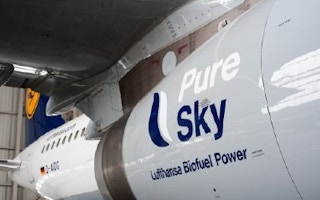The aviation industry has set ambitious targets to green its industry but its success will depend on the availability of sustainable biofuel sources, say experts.
Speaking at a briefing in Singapore recently, German airline Lufthansa’s vice president of environmental issues, Dr Karlheinz Haag, said: “There’s no silver bullet approach.”
The industry is striving towards carbon neutral growth by 2020 - meaning that carbon emissions remain steady even as global air travel increases - and to halve its carbon dioxide emissions from 2005 levels by 2050. This was a target set in 2007 by the International Air Transport Association (IATA) with the support of the aviation sector.
Members of IATA’s environment committee, which includes Dr Haag, have recommended a mix of initiatives that will help the industry achieve the goal, including technological innovations, improved airport infrastructure, improvements in operations such as more efficient flight plans and ground operations, and economic incentives.
Since 1990, the aviation industry has improved fuel efficiency by about 80 per cent through technological improvements, an equivalent of 3.3 billion tonnes of carbon dioxide saved. The next big opportunities for improvement, according to IATA, are better air traffic management and biofuels.
Now, airlines are lining up to add biofuels to their fuel mix.
On 15 July, Lufthansa became the first airline to use biofuels on commercial flights when it started a six-month pilot project to test the effects of biofuels on flights between Frankfurt and Hamburg.
Using a biofuel that is 50 per cent conventional kerosene and 50 per cent biofuel – the maximum blend currently allowed under industry safety standards – Lufthansa has so far found that the fuel performs exactly as expected, the mark of a successful trial.
Lufthansa’s biofuel, produced by Finnish refiner Neste Oil, is derived primarily from vegetable oils such as jatropha, camelina and soybean oil.
Other airlines, including London-based British Airways and the Australian airline Qantas, are researching biofuels derived from liquefied commercial waste in a process previously used for coal.
Joachim Buse, Lufthansa’s vice president of Aviation Biofuel, noted that the company’s fuel consumption for 2010 was 11.3 million cubic metres (m³), or about 1,100 tanker trucks per day. In 2020, consumption is projected to be 13.6 million m³. To meet IATA goals, which call for biofuels to supply four per cent of total fuel demand, Lufthansa alone will need 530,000m³ of biofuel for the year.
Neste’s vice president of business development, Janne Mielch, noted that unfortunately, the capacity to meet the sector’s projected biofuel demand “doesn’t exist yet”.
Neste produces about 90 per cent of the world’s renewable aviation fuel at its plants in Finland and at its 800,000 tonnes per annum (t/a) plant in Tuas in Singapore, which is currently the world’s largest biofuel plant.
Mr Mielck said that Neste will expand capacity by widening its raw material base to include non-plant sources such as oil from fish processing, used cooking oil, and eventually experimental sources such as algae or oil produced from bacteria. Sources are likely to be highly fragmented, he noted, adding that no one single source would be enough.
Lufthansa’s Mr Buse noted that raw materials, or feedstock, contribute to about two thirds of the cost of biofuels. Bringing those costs down will be crucial to the industry’s uptake of biofuels, which cost roughly twice as much as conventional fuel. “We cannot double our fuel bill, so we have to find ways to get fuel prices down,” he said.
One of the primary biofuel feedstocks that Neste uses is jatropha oil supplied by Jatro AG, an agribusiness firm based in both Germany and Singapore. The jatropha tree, with its cashew-sized nut, is known as one of highest yielding oilseed plants in world.
Jatro chief executive Dr Christof Weber said jatropha oil had the added advantage of not competing with food crops for land. The nuts that produce the oil are non-edible and the tree is grown on marginal land, interspersed with food plants that would not grow on their own in the given location, he noted.
He added that no irrigation was needed and that the tree plantations, planted with a wide variety of different plant species, qualified as reforestation under international land use policies.
He is not the only one to recognise the benefits of jatropha oil. Dr Weber, who estimates the biofuels market could reach US$11 to 19 billion by 2020, told Eco-Business he has requests from 12 airlines, some of them Asian, for jatropha oil supplies. He was unable to disclose company names at the time of the interview.
Dr Weber, whose company grows jatropha throughout Southeast Asia, as well as in India, China, Brazil, Mexico and parts of Africa, said that Asia, with its strong financial powerhouses, would be key to meeting the aviation industry’s imminent demand for biofuel.
“Honestly, this is an Asian game. The scale you need can only be reached in Southeast Asia at this point in time,” he said.
“We’ve got more than a million hectares available there. It’s only a question of scaling up,” he added.










